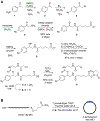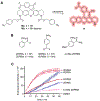Small Molecule Control of Morpholino Antisense Oligonucleotide Function through Staudinger Reduction
- PMID: 34705461
- PMCID: PMC9014490
- DOI: 10.1021/jacs.1c08723
Small Molecule Control of Morpholino Antisense Oligonucleotide Function through Staudinger Reduction
Abstract
Conditionally activated, caged morpholino antisense agents (cMOs) are tools that enable the temporal and spatial investigation of gene expression, regulation, and function during embryonic development. Cyclic MOs are conformationally gated oligonucleotide analogs that do not block gene expression until they are linearized through the application of an external trigger, such as light or enzyme activity. Here, we describe the first examples of small molecule-responsive cMOs, which undergo rapid and efficient decaging via a Staudinger reduction. This is enabled by a highly flexible linker design that offers opportunities for the installation of chemically activated, self-immolative motifs. We synthesized cyclic cMOs against two distinct, developmentally relevant genes and demonstrated phosphine-triggered knockdown of gene expression in zebrafish embryos. This represents the first report of a small molecule-triggered antisense agent for gene knockdown, adding another bioorthogonal entry to the growing arsenal of gene knockdown tools.
Conflict of interest statement
The authors declare no competing financial interest.
Figures






Similar articles
-
Bicyclic Caged Morpholino Oligonucleotides for Optical Gene Silencing.Chembiochem. 2022 Nov 4;23(21):e202200374. doi: 10.1002/cbic.202200374. Epub 2022 Oct 6. Chembiochem. 2022. PMID: 36068175 Free PMC article.
-
Combinatorial control of gene function with wavelength-selective caged morpholinos.Methods Enzymol. 2019;624:69-88. doi: 10.1016/bs.mie.2019.04.007. Epub 2019 Apr 25. Methods Enzymol. 2019. PMID: 31370936 Free PMC article.
-
Conditional gene knockdowns in sea urchins using caged morpholinos.Dev Biol. 2021 Jul;475:21-29. doi: 10.1016/j.ydbio.2021.02.014. Epub 2021 Mar 5. Dev Biol. 2021. PMID: 33684434 Free PMC article.
-
Caged oligonucleotides for studying biological systems.J Inorg Biochem. 2015 Sep;150:182-8. doi: 10.1016/j.jinorgbio.2015.03.010. Epub 2015 Mar 28. J Inorg Biochem. 2015. PMID: 25865001 Free PMC article. Review.
-
Morpholino antisense oligonucleotides: tools for investigating vertebrate development.Genome Biol. 2001;2(5):REVIEWS1015. doi: 10.1186/gb-2001-2-5-reviews1015. Epub 2001 Apr 26. Genome Biol. 2001. PMID: 11387041 Free PMC article. Review.
Cited by
-
Modular and automated synthesis of oligonucleotide-small molecule conjugates for cathepsin B mediated traceless release of payloads.RSC Chem Biol. 2024 May 29;5(8):738-744. doi: 10.1039/d4cb00112e. eCollection 2024 Jul 31. RSC Chem Biol. 2024. PMID: 39092443 Free PMC article.
-
Ortho-Phosphinoarenesulfonamide-Mediated Staudinger Reduction of Aryl and Alkyl Azides.Molecules. 2022 Sep 5;27(17):5707. doi: 10.3390/molecules27175707. Molecules. 2022. PMID: 36080474 Free PMC article.
-
Expanding the Genetic Code of Xenopus laevis Embryos.ACS Chem Biol. 2024 Feb 16;19(2):516-525. doi: 10.1021/acschembio.3c00686. Epub 2024 Jan 26. ACS Chem Biol. 2024. PMID: 38277773 Free PMC article.
-
Bicyclic Caged Morpholino Oligonucleotides for Optical Gene Silencing.Chembiochem. 2022 Nov 4;23(21):e202200374. doi: 10.1002/cbic.202200374. Epub 2022 Oct 6. Chembiochem. 2022. PMID: 36068175 Free PMC article.
-
Conditional Control of Benzylguanine Reaction with the Self-Labeling SNAP-tag Protein.Bioconjug Chem. 2025 Mar 19;36(3):540-548. doi: 10.1021/acs.bioconjchem.5c00002. Epub 2025 Feb 20. Bioconjug Chem. 2025. PMID: 39977950 Free PMC article.
References
-
- Chakraborty S; Mehtab S; Krishnan Y The predictive power of synthetic nucleic acid technologies in RNA biology. Acc. Chem. Res 2014, 47 (6), 1710–9. - PubMed
-
- Setten RL; Rossi JJ; Han SP The current state and future directions of RNAi-based therapeutics. Nat. Rev. Drug Discovery 2019, 18 (6), 421–446. - PubMed
-
- Summerton JE Morpholino, siRNA, and S-DNA compared: impact of structure and mechanism of action on off-target effects and sequence specificity. Curr. Top. Med. Chem 2007, 7 (7), 651–60. - PubMed
Publication types
MeSH terms
Substances
Grants and funding
LinkOut - more resources
Full Text Sources
Molecular Biology Databases

